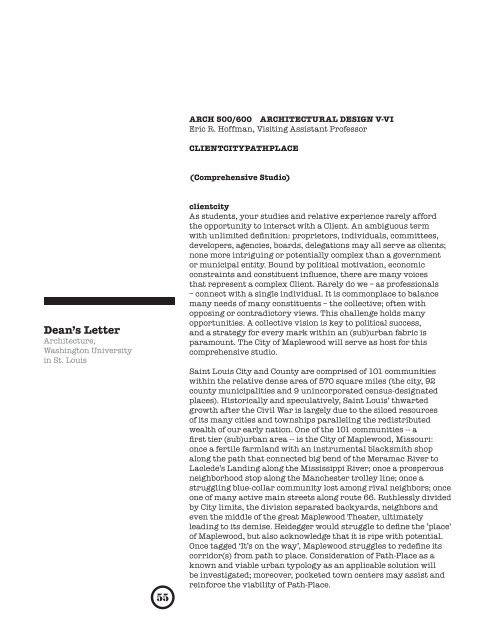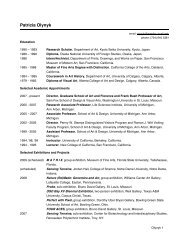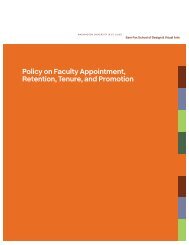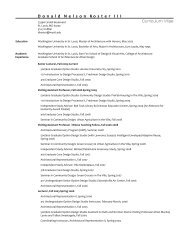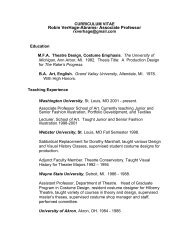architecture - Sam Fox School - Washington University in St. Louis
architecture - Sam Fox School - Washington University in St. Louis
architecture - Sam Fox School - Washington University in St. Louis
Create successful ePaper yourself
Turn your PDF publications into a flip-book with our unique Google optimized e-Paper software.
Dean’s Letter<br />
Architecture,<br />
<strong>Wash<strong>in</strong>gton</strong> <strong>University</strong><br />
<strong>in</strong> <strong>St</strong>. <strong>Louis</strong><br />
55<br />
ARCH 500/600 ARCHITECTURAL DESIGN V-VI<br />
Eric R. Hoffman, Visit<strong>in</strong>g Assistant Professor<br />
CLIENTCITYPATHPLACE<br />
(Comprehensive <strong>St</strong>udio)<br />
clientcity<br />
As students, your studies and relative experience rarely afford<br />
the opportunity to <strong>in</strong>teract with a Client. An ambiguous term<br />
with unlimited def<strong>in</strong>ition: proprietors, <strong>in</strong>dividuals, committees,<br />
developers, agencies, boards, delegations may all serve as clients;<br />
none more <strong>in</strong>trigu<strong>in</strong>g or potentially complex than a government<br />
or municipal entity. Bound by political motivation, economic<br />
constra<strong>in</strong>ts and constituent <strong>in</strong>fluence, there are many voices<br />
that represent a complex Client. Rarely do we – as professionals<br />
– connect with a s<strong>in</strong>gle <strong>in</strong>dividual. It is commonplace to balance<br />
many needs of many constituents – the collective; often with<br />
oppos<strong>in</strong>g or contradictory views. This challenge holds many<br />
opportunities. A collective vision is key to political success,<br />
and a strategy for every mark with<strong>in</strong> an (sub)urban fabric is<br />
paramount. The City of Maplewood will serve as host for this<br />
comprehensive studio.<br />
Sa<strong>in</strong>t <strong>Louis</strong> City and County are comprised of 101 communities<br />
with<strong>in</strong> the relative dense area of 570 square miles (the city, 92<br />
county municipalities and 9 un<strong>in</strong>corporated census-designated<br />
places). Historically and speculatively, Sa<strong>in</strong>t <strong>Louis</strong>’ thwarted<br />
growth after the Civil War is largely due to the siloed resources<br />
of its many cities and townships parallel<strong>in</strong>g the redistributed<br />
wealth of our early nation. One of the 101 communities -- a<br />
first tier (sub)urban area -- is the City of Maplewood, Missouri:<br />
once a fertile farmland with an <strong>in</strong>strumental blacksmith shop<br />
along the path that connected big bend of the Meramac River to<br />
Laclede’s Land<strong>in</strong>g along the Mississippi River; once a prosperous<br />
neighborhood stop along the Manchester trolley l<strong>in</strong>e; once a<br />
struggl<strong>in</strong>g blue-collar community lost among rival neighbors; once<br />
one of many active ma<strong>in</strong> streets along route 66. Ruthlessly divided<br />
by City limits, the division separated backyards, neighbors and<br />
even the middle of the great Maplewood Theater, ultimately<br />
lead<strong>in</strong>g to its demise. Heidegger would struggle to def<strong>in</strong>e the ’place’<br />
of Maplewood, but also acknowledge that it is ripe with potential.<br />
Once tagged ‘It’s on the way’, Maplewood struggles to redef<strong>in</strong>e its<br />
corridor(s) from path to place. Consideration of Path-Place as a<br />
known and viable urban typology as an applicable solution will<br />
be <strong>in</strong>vestigated; moreover, pocketed town centers may assist and<br />
re<strong>in</strong>force the viability of Path-Place.


